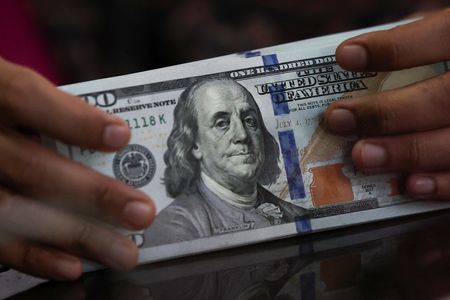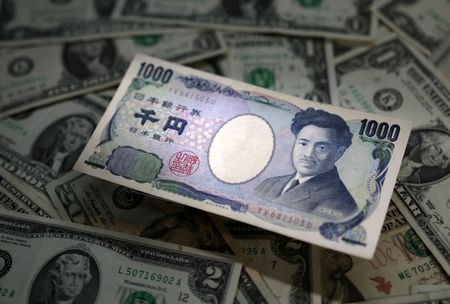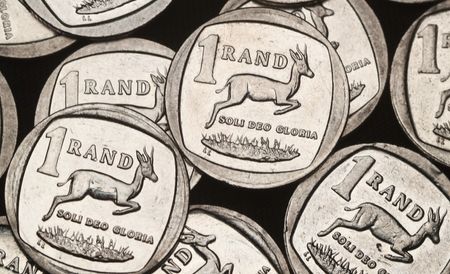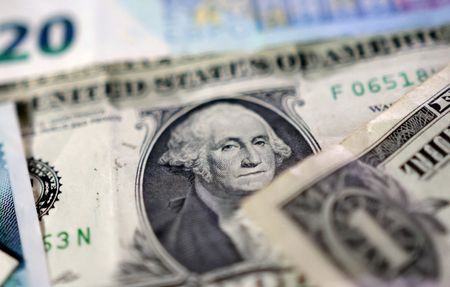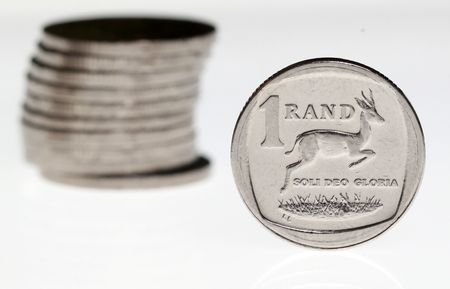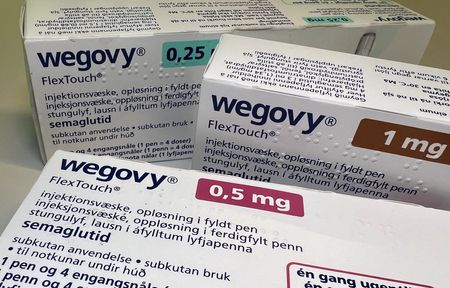By Stefano Rebaudo
(Reuters) -The dollar slipped on Friday with investors cautious about the rate outlook ahead of import price data, after recent figures suggested inflation could accelerate in the coming months.
The yen outperformed the euro and the pound following the release of surprisingly strong Japanese growth data, which showed export volumes held up well against new U.S. tariffs.
All eyes will be on a meeting in Alaska later on Friday between Donald Trump and his Russian counterpart Vladimir Putin, focused on the U.S. president’s push to seal a ceasefire deal on Ukraine.
U.S. import price figures will be more closely watched than usual after data on Thursday showed a sharp jump in producer prices last month, pushing the dollar higher.
If import prices keep rising, it may signal that U.S. companies are fully absorbing the tariffs, leaving them with two options: pass the costs on to consumers, potentially stoking inflation, or take the hit to profit margins.
Money markets reflect a 95% chance of a 25-basis point Fed rate cut in September. They fully priced a 25-bp cut and a 5% chance of a larger 50-bp move before Thursday’s U.S. data.
Markets also await next week’s Jackson Hole symposium for clues on the Fed’s next move. Signs of weakness in the U.S. labour market combined with inflation from trade tariffs could present a dilemma for the Fed’s rate cut trajectory.
The U.S. dollar index, that measures the value of the greenback relative to a basket of six major foreign currencies, was down 0.33% at 97.882.
However, it’s not just a matter of rate outlook divergence according to some analysts.
Morgan Stanley estimates that the dollar risk premium is currently 6% compared to a range of 5% to 9% since April.
The bank sees ample scope for it to return to, or even exceed, those peaks, potentially weakening the U.S. currency, because investors are increasing the share of their U.S. asset exposure that is hedged against exchange rate risks.
After Trump’s so-called Liberation Day tariff announcements, markets sold off U.S. assets, including the greenback, on fears that Washington was about to launch a trade war against its major allies.
The yen was up 0.56% against the dollar at 146.94, helped by data showing Japan’s economy grew much faster than expected in the second quarter.
U.S. Treasury Secretary Scott Bessent’s remarks earlier this week that the Bank of Japan could be “behind the curve” in dealing with the risk of inflation proved to be another tailwind for the yen.
“Although BoJ Governor Ueda may choose to disregard Bessent’s remarks, the Japanese authorities will not want the value of the yen to become more of a concern to the Trump administration than it already is,” said Jane Foley senior forex strategist at RaboBank.
The euro rose 0.34% versus the dollar to $1.1687.
Most analysts expect Europe’s single currency to benefit from any ceasefire deal in Ukraine.
“The Trump-Putin meeting and any better clarity on the path ahead in the Ukraine conflict have longer-lasting implications for the euro than for the dollar,” said Francesco Pesole, forex strategist at ING.
“There is a chance that today might be the first step in the direction of de-escalation, and markets may tread carefully for now,” he added.
The pound was up 0.24% against the U.S. currency at $1.3563.
The Australian dollar was up 0.25% versus the greenback at 0.6512.
Elsewhere, bitcoin and ether rose after dropping about 4% each on Thursday. Bitcoin had at one point touched a record high on Thursday on shifting Fed rate-cut expectations.
(Reporting by Stefano Rebaudo; Editing by Shri Navaratnam, Kim Coghill, Christina Fincher and Joe Bavier)

